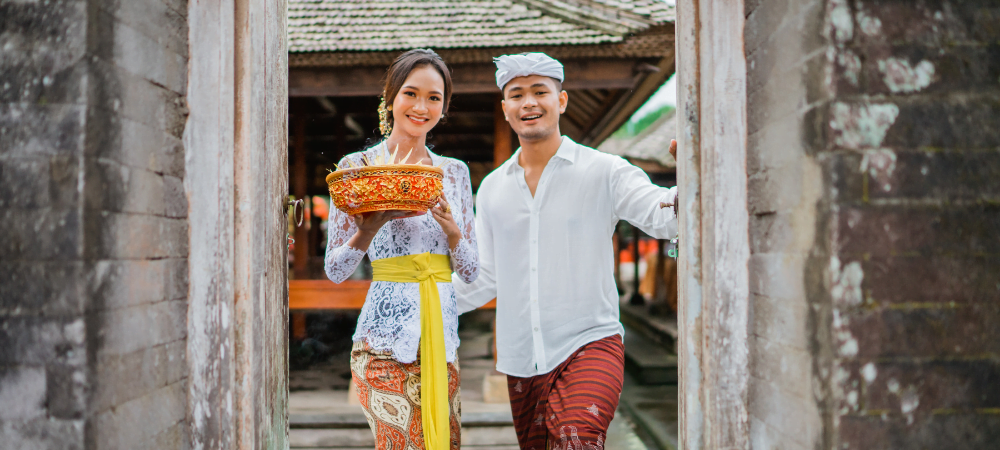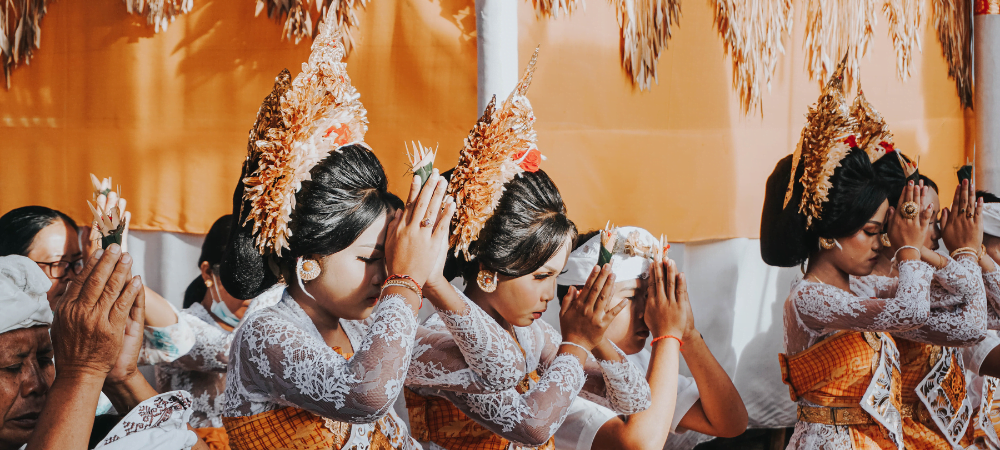Traditional Balinese Clothing: Symbolism, Styles & Cultural Significance
Traditional Balinese clothing is more than ceremonial—it’s a symbol of the island’s deep spirituality, cultural identity, and artistic heritage. From the intricate kebaya and kamen worn by women to the dignified udeng and safari shirts of men, every garment has meaning.
The Balinese people don their traditional clothes not only as a mark of respect and honour for their rituals and ceremonies but also as a way to keep their rich cultural legacy alive in the modern world. In this guide, we’ll explore what traditional Balinese attire looks like, when it’s worn, and how visitors can respectfully participate in these cultural traditions.
Key Takeaways
- Traditional Balinese clothing reflects deep cultural and spiritual values, with every piece—from the kebaya to the udeng—carrying symbolic meaning.
- Balinese women typically wear kebaya, kamen (sarong), and a prada belt, while men wear a safari shirt, kamen, and udeng headscarf.
- Colours have significance: white represents purity (often worn during ceremonies), while other colours reflect mood, purpose, or occasion.
- Clothing etiquette is crucial during temple visits, including covering shoulders and knees, wearing a sarong and sash, and respecting ritual customs.
- Modern versions of Balinese attire blend tradition with style, making them accessible for tourists to wear respectfully during cultural experiences.
- Visitors can buy or rent traditional clothes in areas like Ubud and Seminyak, often near temples or local markets.
Types of Traditional Balinese Clothes
Women’s Attire: Grace and Tradition
- Balinese Kebaya: Resembling the Javanese Kebaya but unique in its motifs and color, the Balinese Kebaya often features bright colors and simple designs. It’s usually paired with a shawl tied like a belt, enhancing the elegance of the wearer.
- Prada Belt: This belt, typically worn by women to hold Kamen, is not just a fashion accessory but a symbol. Embellished with Balinese motifs and vibrant colors, it represents the protection of a woman’s body, a revered aspect in Balinese culture.
- Kamben: The Kamben, similar to a sarong, is wrapped tightly around women, ensuring a neat appearance without visible folds or drapes. It’s a key element in women’s traditional dress, reflecting modesty and respect for cultural norms.
Men’s Attire: A Blend of Simplicity and Dignity
- Safari Shirt: A staple in the wardrobe of Balinese men, the Safari shirt is distinguished by its collar, pockets, and predominantly white color, symbolizing cleanliness. It’s a common sight in both religious and everyday settings.
- Udeng: The Udeng serves as a traditional head covering for men. Made from fabric, it’s tied to form a knot in the middle. There are two types: plain Udeng for religious ceremonies and colored Udeng for daily activities, reflecting different cultural contexts.
- Kamen: This traditional cloth, resembling a sarong, is worn differently by men and women. Men tie the Kamen around the waist, forming a knot symbolizing devotion or dharma. The precise way it’s worn, including the distance from the ground, carries deep cultural significance.
Ceremonial Attire: The Essence of Bali’s Rituals
During important ceremonies like weddings or temple rituals, Balinese attire becomes more elaborate. Gold-plated headdresses and accessories are common, adding a regal and sacred dimension to the ensemble. This attire represents a deeper connection to the spiritual and ancestral world, illustrating the island’s rich tapestry of beliefs and traditions.
The Symbolism Behind the Attire
In Balinese culture, every aspect of traditional clothing is imbued with deep symbolism and meaning, reflecting the island’s spiritual beliefs and social customs.
- Color Symbolism: The choice of color in Balinese attire is highly significant. White, often seen in Payas Alit and men’s safari shirts, symbolizes purity and is predominantly used in religious settings. Meanwhile, the vibrant colors of the kebaya and Prada belts worn by women during festivals and ceremonies celebrate the island’s love for life and nature. The use of specific colors for different occasions, like black for cremations, illustrates the Balinese respect for the cycle of life and death.
- Udeng – A Symbol of Wisdom: The udeng is more than a head covering; it represents wisdom and maturity in men. The way it is tied and worn signifies the wearer’s status and role within the community, making it a key cultural symbol in Balinese society.
- Kamen and Respect for Tradition: The kamen, tied with a specific knot, is not just a piece of cloth but a representation of devotion or dharma. The meticulous way in which it is worn, including its length and the sharpness of its knots, is a gesture of respect towards the ancestral land and the island’s customs.
- Kebaya – A Blend of Modesty and Style: The kebaya, while influenced by external cultures, has been embraced and adapted by Balinese women to represent their grace and modesty. The choice of fabric, length, and style of the kebaya worn at different events signifies the island’s adaptability and respect for cultural norms.
- Prada Belt – A Symbol of Protection: The Prada belt, adorned with intricate Balinese motifs, is not just an accessory. It symbolizes the protection of a woman’s body, particularly the abdomen, reflecting the island’s deep respect for the feminine and the divine.
How to Dress Respectfully at Balinese Temples
The Balinese culture is steeped in tradition and respect, and this extends to the etiquette and customs surrounding traditional clothing, especially in religious and ceremonial contexts.
- Dress Code for Religious Ceremonies and Temples: In Bali, dressing appropriately for religious ceremonies and temple visits is paramount. Both men and women are expected to cover their shoulders and knees as a sign of respect. Sarongs and temple scarves, often available for rent at temple entrances, are commonly used for this purpose. Additionally, menstruating women and individuals with open wounds are traditionally not permitted to enter temples, reflecting the cultural emphasis on spiritual cleanliness.
- Cultural Norms Surrounding Traditional Clothing: Wearing traditional Balinese clothing is not just about adhering to a dress code; it’s about showing respect for the island’s customs and traditions. For instance, the precise manner of wearing the kamen or the kebaya is a way of honoring the cultural heritage. Moreover, the Balinese people take care to not step on or move the Canang Sari, the daily offerings made to thank the gods, as a sign of respect.
- Mindful Behavior in Sacred Spaces: In Balinese temples and other sacred spaces, specific behaviors are observed to maintain the sanctity of these places. For example, while wearing a sarong and sash, one should also be mindful of their posture, such as sitting with feet tucked underneath and not pointing towards any altar. Climbing onto altars for photographs or standing or sitting in positions that disrespect the temple norms is strongly discouraged.
- Respect for Priests and Rituals: During religious ceremonies, special attention is given to the priests or Mangku. It is considered disrespectful to sit next to, or higher than, the priest, or to obstruct their view. Maintaining a respectful distance and demeanor is key to showing reverence in these settings.
Modern Versions of Balinese Traditional Clothing
The allure of traditional Balinese clothing has evolved to meet the tastes and needs of the modern era while preserving its cultural essence.
- Evolution and Modern Interpretations: While deeply rooted in tradition, Balinese clothing has embraced contemporary influences, resulting in a fusion of classic and modern styles. Designers and artisans blend traditional motifs with new materials and techniques, creating fashion pieces that appeal to both locals and tourists. This fusion has helped in keeping the traditional wear relevant and accessible to a broader audience.
- Preservation and Promotion of Traditional Clothing: Efforts to keep the Balinese clothing tradition alive are vigorous. Artisans, cultural enthusiasts, and fashion designers work tirelessly to preserve the techniques and skills involved in creating these garments. Educational programs and cultural workshops often showcase these traditional practices, ensuring that the knowledge and heritage are passed down to future generations.
Where to Buy or Rent Traditional Balinese Clothes
- Availability for Tourists and Visitors: Traditional Balinese attire is readily available for tourists who wish to immerse themselves in the local culture. Many shops, ranging from traditional markets to modern concept stores, offer a wide variety of Balinese clothing. Rental services are also available, especially near cultural sites and temples, allowing visitors to participate in local traditions and ceremonies appropriately dressed.
- Respecting Cultural Sensitivities: While wearing traditional Balinese clothing can be a delightful experience for visitors, it’s important to approach this with respect for cultural sensitivities. Visitors are encouraged to learn about the cultural importance of these clothes and wear them in a way that honors Balinese traditions.
Traditional Balinese clothing remains a vibrant and essential aspect of the island’s cultural identity. Its evolution and availability signify Bali’s openness to sharing its heritage with the world, inviting visitors to not only witness but also partake in its rich cultural tapestry. Whether it’s through wearing a simple Kebaya or the more elaborate ceremonial attire, each garment tells the story of Bali’s artistic and spiritual journey through the ages.
In Closing
If you’re planning to immerse yourself in the enchanting Balinese culture, there’s no better way to start than by experiencing the comfort and luxury of My Villas in Bali. Whether you’re here to explore the island’s cultural landmarks, participate in traditional ceremonies, or simply bask in the serene beauty of Bali, My Villas in Bali offers the perfect base for your journey. Our villas provide not just a place to stay, but a gateway to experiencing the authentic Balinese way of life.
So why wait? Book your stay at My Villas in Bali today, and prepare to be enveloped in the warmth, tradition, and elegance that this magical island has to offer.
FAQ
What is traditional Balinese clothing called?
Traditional Balinese clothing includes items like the kebaya for women and the kamen (a type of sarong) for both men and women. Men also wear the udeng headscarf and safari shirts, while women pair their outfits with a decorative prada belt.
When do Balinese people wear traditional clothes?
Balinese people wear traditional attire during religious ceremonies, temple visits, festivals, weddings, and other cultural rituals. It’s also common for locals to wear these outfits on certain days of the week, such as temple days (odalan).
Can tourists wear traditional Balinese clothes?
Yes, tourists are welcome to wear traditional Balinese clothing, especially when visiting temples or attending ceremonies. It’s a sign of respect—just make sure to wear it appropriately, covering the shoulders and knees, and follow local customs.
What does the udeng symbolize?
The udeng, a headscarf worn by Balinese men, symbolizes focus, wisdom, and spiritual awareness. It is tied in a specific way, often with a central knot that represents a balanced mind and body.
Where can I buy or rent Balinese traditional clothing?
You can buy or rent traditional Balinese clothing in areas like Ubud, Seminyak, and around popular temples. Local markets, boutique stores, and even some temples offer sarong and sash rentals for visitors.
- Welcome Back To My Villas in Bali - November 17, 2021





